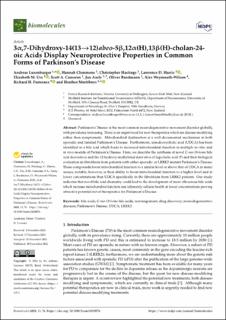| dc.contributor.author | Luxenburger, Andreas | |
| dc.contributor.author | Clemmens, Hannah | |
| dc.contributor.author | Hastings, Christopher | |
| dc.contributor.author | Harris, Lawrence D. | |
| dc.contributor.author | Ure, Elizabeth M. | |
| dc.contributor.author | Cameron, Scott A. | |
| dc.contributor.author | Aasly, Jan | |
| dc.contributor.author | Bandmann, Oliver | |
| dc.contributor.author | Weymouth-Wilson, Alex | |
| dc.contributor.author | Furneaux, Richard H. | |
| dc.contributor.author | Mortiboys, Heather | |
| dc.date.accessioned | 2023-10-26T09:13:49Z | |
| dc.date.available | 2023-10-26T09:13:49Z | |
| dc.date.created | 2023-05-08T09:16:03Z | |
| dc.date.issued | 2023 | |
| dc.identifier.citation | Biomolecules. 2023, 13 (1), . | en_US |
| dc.identifier.issn | 2218-273X | |
| dc.identifier.uri | https://hdl.handle.net/11250/3098879 | |
| dc.description.abstract | Parkinson’s Disease is the most common neurodegenerative movement disorder globally, with prevalence increasing. There is an urgent need for new therapeutics which are disease-modifying rather than symptomatic. Mitochondrial dysfunction is a well-documented mechanism in both sporadic and familial Parkinson’s Disease. Furthermore, ursodeoxycholic acid (UDCA) has been identified as a bile acid which leads to increased mitochondrial function in multiple in vitro and in vivo models of Parkinson’s Disease. Here, we describe the synthesis of novel C-nor-D-homo bile acid derivatives and the 12-hydroxy-methylated derivative of lagocholic acid (7) and their biological evaluation in fibroblasts from patients with either sporadic or LRRK2 mutant Parkinson’s Disease. These compounds boost mitochondrial function to a similar level or above that of UDCA in many assays; notable, however, is their ability to boost mitochondrial function to a higher level and at lower concentrations than UDCA specifically in the fibroblasts from LRRK2 patients. Our study indicates that novel bile acid chemistry could lead to the development of more efficacious bile acids which increase mitochondrial function and ultimately cellular health at lower concentrations proving attractive potential novel therapeutics for Parkinson’s Disease. | en_US |
| dc.language.iso | eng | en_US |
| dc.publisher | MDPI | en_US |
| dc.rights | Navngivelse 4.0 Internasjonal | * |
| dc.rights.uri | http://creativecommons.org/licenses/by/4.0/deed.no | * |
| dc.title | 3α,7-Dihydroxy-14(13→12)abeo-5β,12α(H),13β(H)-cholan-24-oic Acids Display Neuroprotective Properties in Common Forms of Parkinson’s Disease | en_US |
| dc.title.alternative | 3α,7-Dihydroxy-14(13→12)abeo-5β,12α(H),13β(H)-cholan-24-oic Acids Display Neuroprotective Properties in Common Forms of Parkinson’s Disease | en_US |
| dc.type | Peer reviewed | en_US |
| dc.type | Journal article | en_US |
| dc.description.version | publishedVersion | en_US |
| dc.source.pagenumber | 0 | en_US |
| dc.source.volume | 13 | en_US |
| dc.source.journal | Biomolecules | en_US |
| dc.source.issue | 1 | en_US |
| dc.identifier.doi | 10.3390/biom13010076 | |
| dc.identifier.cristin | 2146046 | |
| cristin.ispublished | true | |
| cristin.fulltext | original | |
| cristin.qualitycode | 1 | |

